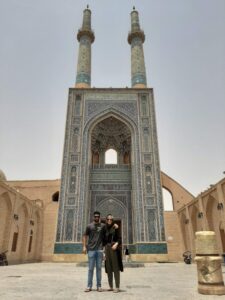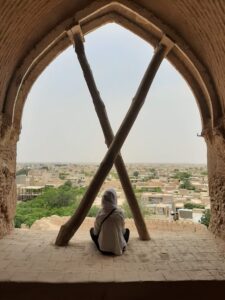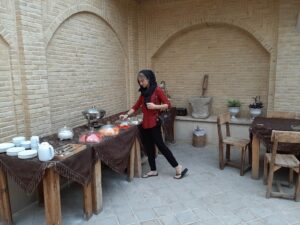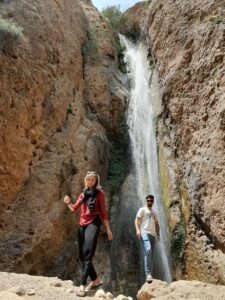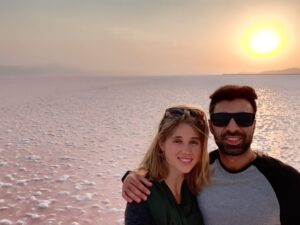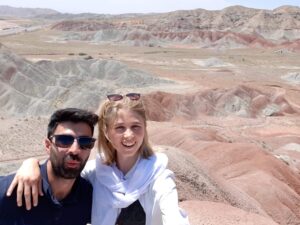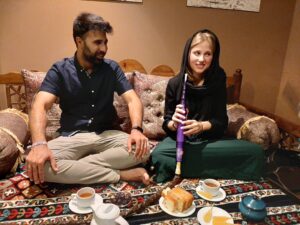iran
Iran is a massive country with various types of scenery, all of which are worth exploring. Although Iran’s fascinating history, amazing cities and interesting culture are what attract most people, there is an amazing range of natural sites to discover and wander through. From cool and hilly forests in the north, and mystique rock formations on islands such as Qeshm in the south to burning deserts with amazing scenery like Dasht-e-Lut and so much more! Enjoy the freedom that comes with Overlanding and discover the pristine nature of Iran!
Border crossing
Border crossings in Iran are always stressful since things may go wrong if you’re unlucky. That being said, the chances of something bad happening are very slim. Even at one of the most politically unstable times in Iran (2022), there were quite some foreign tourists and overlanders in the country and faced little to no problems. So always keep in mind that social media and news will exaggerate the situation and that your country’s travel advice will often be negative, even with the slightest instability. This doesn’t necessarily involve you being arrested, captured, murdered or worse BUT it’s possible.
Preparation
Make sure you have: no alcohol, drugs, or pornography in your car. Avoid food containing pork. Don’t show off cameras, drones, or dashcams. Smartphones might be checked so make sure you have no videos of protests in Iran or anything that might be considered provocative/insulting to the government or make you suspicious. We deleted all our socials to avoid being checked on those. Although drones can be taken into Iran, be aware that you can’t fly anywhere in Iran. There have been people doing it and were sent to jail. Iran is very unstable at the moment and probably will remain this way until some change in government (not any time soon we think). Any provocation, even taking a drone with you for instance although it is legal, might bring you in trouble. Get your story straight and know exactly where you want to go in Iran and have a hotel reservation ready for the first night at least. Once you’re in Iran, if you remain low-key, chances are very slim people/officials/police will bother you or arrest you. Border crossings involve the highest risk so just be prepared to avoid trouble. That being said, we met a French guy who openly shared his negative opinion on Iranian government and even went to protests while in Iran and after staying multiple months in the country, he left without any trouble after a small interrogation at the airport.
Exit Turkey
You must park your car and get an exit stamp in your passport first. After that, only passengers are allowed to walk to the Iranian immigration while the driver has to finalize customs procedures for the car and cross the border with car to Iranian immigration after.
Customs procedure: show vehicle registration, carnet de passage and exit stamp in passport. Pay any fines (speeding and unpaid toll (HGS)) at a different booth (this took us 3 hours because the guy was having lunch) and you’ll be ready to drive through the gate.
Enter Iran
You have to show your passport, visa and in some cases (2022) proof of COVID vaccination at immigration. We just showed the vaccination certificate on our government app on the smartphone and it was fine. You will get an entry stamp and again, passengers will take a different route while the driver has to take the car to customs (although in our case the passenger was allowed to go with to the car). At customs, you hand over the carnet de passage and vehicle registration. They might ask for hard copies of both, but since we didn’t have any, they copied it themselves. After that you see the papers going from person to person for some while until it’s time to get your vehicle inspected. They will ask you if you have alcohol or drugs with you, just say no and smile. They just take a quick look in your vehicle and are more impressed and curious than actually inspecting anything. In our case, a nice guy (lower ranked official, not a random guy) ran the process and speeded things along. He even told us that he got us out of doing an X-RAY on the car which would have cost us way more you. In return for his ‘favor’ he asked for a ‘lil sometin’ and we gave him €5 in Turkish Lira.
Visa
First, you must contact an Iranian agency to request a reference number (RN). This costs 30 euros per person. Once you have transferred the money they will forward the reference number to you within 4-7 working days (working days are from Saturday to Wednesday). We contacted Caravanistan.
Contact details: loi@caravanistan.com
To apply for a reference number, you need to fill out the visa application form on their website (they will send you the link) and upload a copy of your passport and a photo (size does not matter and you are not required to wear a scarf). You also have to send them an itinerary with the exact number of days you are going to stay in Iran, what route you are going to take, what cities you want to visit and which hotels you are going to stay. We had booked a hotel for the first night but not for the nights after that. We never slept in the hotel we put on our itinerary. In fact, it doesn’t really matter if you follow your original plan or not. They basically just need to have an idea of what you are going to do. Whatever how many days you planned to stay in Iran, they will give you a minimum of 45-day visa anyway. But take some time in advance to make a proper realistic itinerary just to make sure they’re not going to be difficult at the embassy to give you a visa. It is also good for yourself to take a look at what you want to see and where you want to sleep each night. Iran is huge and you want to sleep in one of the big, well-known cities so you should have an idea of which cities you can reach in one day. Getting a sim card in Iran is difficult for a foreigner and even at your hotel you rarely have wifi. So make sure you download the map of Iran before you enter and that you have kind of an idea of what you want to see because you are not going to have enough internet to look everything up once you are in Iran.
Important to know that when you apply for an RN it is only valid for 1 month. So when you get this RN you have to go to an Iranian embassy within 1 month to apply for your visa. You can go to an Iranian embassy anywhere in the world.
We filled in the visa application form and 7 days later we got an email with a completed visa form and RN code. This already looks like a valid visa but it is not yet valid. You have to print out this form and go with it to an Iranian embassy somewhere in the world. We went to the Iranian embassy in Istanbul, Turkey. There you have to wait in line for a visa application. When you get to the desk, they quickly review your itinerary and that is it. They don’t ask any more questions (they also can’t speak very well English either). In our case, we paid 80 euros for a 45-day visa (possible with credit card). I think that with the RN code that you received, you can apply for a visa for a maximum of 90 days but I don’t know for sure. For us 45 days was enough. Once you have paid the amount they put a stamp on your visa form. From then on your visa is valid and you can enter Iran.
Driving in Iran
It is a thrilling and nerve-racking experience. Whether you experience this as enjoyable or you absolutely hate it mostly depends on how often, and how close you get to the brink of death. It should be said that you also can encounter true peace and are able to enjoy the beautiful views you drive through, as long as you stay far from the big cities.
General things to know
– Dangerous but exciting is a short summary of road life in Iran. Especially in and around cities you have to drive really carefully BUT at the same time adjust to the ‘flow’. You’ll find out that it’s actually quite doable.
– In Iran, you drive on the right side of the road and honking is essential for communication.
– Traffic rules are often neglected. Some may drive without lights and overtaking happens on both sides, even sandwich style. Cars are not always in the best shape and most cars are rather old and are made in Iran due to the embargo.
– Police checkpoints are numerous but we were barely ever stopped/checked, except near border crossings. Have your documentation with you at all times and be nice. They are often really kind.
– Toll highways are plenty and you pay in cash.
License plate
if you travel through Iran in less than 10 days, you can keep your foreign license plates. Even if you exceed ten days a little bit, you’ll just pay a fine and can exit Iran without problems. However, if you want to spend lots of time in Iran, you’ll need a license plate (including insurance), which won’t cost you that much and they will help you with everything. After your trip, you hand over your plates at a traffic police station and you’re done.
Insurance
We couldn’t find any insurance and since we were in a rush, we just drove without any until we reached Pakistan (although I wouldn’t really recommend driving without any insurance to anyone since driving in Iran can be really risky).
Fuel
Getting fuel in Iran is a challenge, especially if your vehicle runs on diesel. The reason for this is the fuel card citizens in Iran receive from the government. Every owner of such fuel card (or ‘karde sukht’) gets a fixed monthly amount of petrol (‘benzin’) OR diesel (‘gazoil’) (depending on your vehicle) at a discounted rate, as a way of financial support from the government. If you don’t have a such card, you have to buy fuel ‘free’ (or ‘azad’) which is more expensive but that’s not the biggest problem.
The hardest part is that there are hardly any gas stations that provide such a service. They either don’t have a such card or will tell you that their monthly amount of ‘free’ fuel is already sold out. Luckily, Iranian people are super nice and very helpful. If you own a car that runs on petrol, you are lucky since most gas stations sell petrol and you just have to ask any driver very nicely if he is willing to let you use his fuel card to fill up, and you just pay him after. Do keep in mind that this practice is in fact illegal, so if they agree to help you, it’s just out of niceness.
The same goes with diesel, except it’s much more difficult due to the fact that the only vehicles running on diesel are trucks and potentially some older vans, diesel is almost solely sold on highways and diesel quality is often poor. Find a gas station that sells diesel, ask if they sell ‘free fuel’ (‘gazoil azad’) and if not, wait until a truck driver stops to fill up and ask him if he has some diesel left on his card for you. One other problem is that the government only provides a limited amount of fuel to each person, even to professional truck drivers. This implies that in some areas, especially in the South, it will be hard to find someone who is willing to let you use his card since they just have none to spare. In those cases, you just have to be patient and really nice and keep trying.
Fuel price is ridiculously low in Iran. Often, people were so nice, they wouldn’t accept any money after letting us use their fuel cards. Even if you keep on insisting, they often refuse just because of the Iranian hospitality. In the cases we had to pay for fuel, we never paid more than €5 for a full tank (75 liters).
Our journey
Due to the political instability in Iran at the moment of our visit, we were really hesitant to visit Iran at all. At that time protests broke out all over Iran, due to the death of Mahsa Amini, and even before that some European people were put in jail for no obvious reasons (French, Belgian, Swedish, …). Some of these people were let go quite fast but some of them are still in an Iranian jail. Iranians with double nationality could be considered to be spies, which gives the Iranian officials a ‘reason’ to arrest them. However, due to COVID and the Russian-Ukrainian war, there was not really a different way to reach India than driving through Iran.
Other options are going through Azerbaijan and taking a boat to Kazakhstan or Turkmenistan and then making your way through the Stans. This route has been done by numerous people to reach the Stans, but to reach India or Nepal you either have to go through China (a complicated, expensive and time-consuming process) or cross the Wakhan corridor. The latter corridor is the crossing between Tadzhikistan, Afghanistan and Pakistan (we believe). After looking up some information on this path on the internet, we came to the conclusion that it is not really safe. Although some people have done it and said that it’s doable, apparently it is not safe for female travelers since multiple attempts to rape have happened (also by officials and police).
We prepared well and made sure there was no obvious reason to arrest us. We hid all the cameras out of plain sight, we took no forbidden food/drinks with us and Arman made some calls to people in the government that could help us out in case of trouble (connections of Arman’s way too worried mom). We even sent our drone from Turkey to Pakistan to avoid any risk (which in the end was a terrible thing to do since we lost the drone this way).
My parents and family were scared the most since they were all worked up by watching the news all the time and being involved in the protests. Even though my family would do anything to see me, at the time they told me it was best to leave Iran as soon as possible and avoid stopping in big cities. So we listened, stayed very low key and just drove as fast as possible from the Turkey border to Pakistan border.
Iran is a fantastic country and the older I, Arman, grow the more I feel connected with the culture and habits. Most of my family still lives in Iran and I rarely get to see them so visiting them from time to time is definitely something I’d love to do. We both really looked forward to visiting Iran before we started our journey so it was a though decision to ‘skip’ Iran last minute. However, we were glad we at least visited the country a couple of years ago with our friends.
The entire journey went more or less fine, except for a flat tire in Qazvin. We stayed in hotels and never ‘wild camped’ and didn’t really visit a lot of places except if we really had to. We did explore Isphahan, Qazvin and Yazd a bit when we were there but not as much as we would love to. Having Iranian dishes every day was fantastic and exploring this magnificent cuisine is something I would recommend to everyone.
Exiting Iran
The scariest part of our journey was at the border crossing with Pakistan. At immigration, things got weird. We handed over our passports and someone started chatting with us out of the blue. When the passport check was finalized, the person we were chatting with took our passports and said he had to do some ‘routine checks’ before we were allowed to leave. He appeared to be an official and took our passports to his office while we had to remain seated. Behind us, there was a ‘random’ guy sitting and watching us so we couldn’t leave, just like in the movies.
While we were in Iran, I installed WhatsApp to chat with my family and I forgot to delete the app/messages. My father is a political refugee and his name is blacklisted in Iran meaning they would capture and imprison him if he would ever visit. Before our visit, he suggested me to delete his contact details and if ever questioned, tell the officials I had no contact with him in any way. Sitting there with his messages on my phone creeped me out so I went to the toilet and just deleted everything quickly. The official came back after 15 minutes but didn’t have our passports with him. At that time we thought “it’s done, we’re staying here” and started to freak out. The guy tried to calm us down and said he just needs to ask us some questions. For the next 30 minutes, he asks literally everything about us, my mother, father, brother, family in Iran, parents-in-law, etc. Asking things like the exact address they live in, the company they work for, what they study while growing up, their phone numbers, and so on. After the interrogation, he disappeared again for 15 minutes and eventually came back with our passports and we were allowed to leave.
We have no idea what happened in that room and what they will do with that information. We were just glad we were free to go.
In the end, I’m pretty sure everyone panicked before and during our visit to Iran and we probably could have explored Iran in peace without anything happening to us. However, for us it was just not worth the risk and we’ll gladly go back a different time when things have cooled down again.

